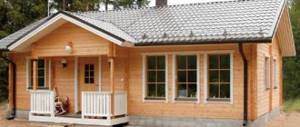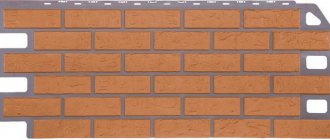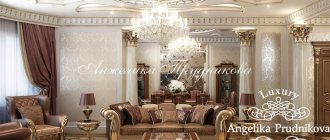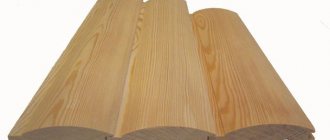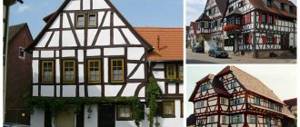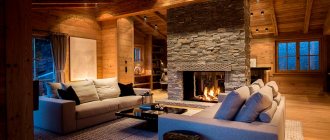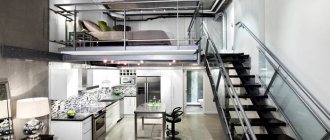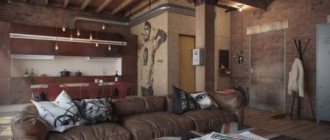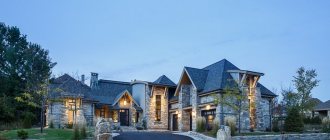A house made of wood is not only an environmentally friendly, but also an aesthetically beautiful structure. Each finishing element has a unique pattern, regardless of the type and age of the lumber. This property of wooden materials is often used when creating interiors of country houses and dachas. At the same time, the house itself can be built from absolutely any materials: to achieve the desired effect, imitation timber is used. Visually it will seem that the house is entirely built of natural wood. In addition, finishing with imitation of the premises of the house will hide minor defects in the walls and give the interior uniqueness.
What is imitation timber?
Modern technologies for the manufacture of finishing materials have reached such a level that the texture of artificially produced elements is practically no different from natural stone or wood. One such example is imitation timber - a practical and beautiful material used for exterior and interior decoration in the construction of private houses. Imitation is also called false timber or clapboard.
To produce imitation timber, different types of wood are used, so the color and texture of different categories of materials differ. Despite this, the imitation is as similar as possible to thick wooden beams, and the difference between them can only be seen upon very close examination.
Imitation of timber - concept
At its core, imitation timber is the same lining, that is, a decorative finishing board. These panels are made from natural solid wood and come in different sizes. Its distinctive feature is the design of the outer surface in the shape of a semicircle or straight, but with beveled edges, which, as a result of finishing, gives the appearance of a building being built from solid or laminated veneer lumber.
Important! You can find out in advance what the imitation timber looks like in the photo.
Options for finishing with imitation timber
Interior decoration with imitation timber involves covering the walls with wooden panels. There are two finishing options:
- monolithic;
- combined.
The monolithic option involves covering all surfaces of the room with false timber, which allows you to create the effect of a monolithic panel. Thanks to the tongue-and-groove system, the panels are tightly attached to each other without gaps.
In the combined version, parts of the room are finished with different materials: the central part is occupied by imitation timber, and neighboring areas are decorated with other materials that match the color and style. This could be wallpaper, tiles, plaster - the choice of finishing option depends on the overall design and your personal preferences.
Sequence of work when finishing a house with imitation timber (inside)
You can begin interior decoration immediately after erecting the walls only in one case - if a frame house was built. In all other situations, it is recommended to give the box time to settle. The exception is when a sliding sheathing is installed to compensate for possible wall movements.
The sequence of finishing with imitation timber can be described something like this:
preparation of the base; taking the dimensions of the surface to be covered; selection of wood species, grade and size of imitation timber; calculation of the amount of material required: imitation, for constructing the sheathing - and fasteners; fastening the sheathing; installation of imitation timber; protection of finishes with special compounds
Advantages and disadvantages of a house with imitation timber
Finishing with imitation timber is very popular today, and this is explained by the advantages and advantages of the material compared to alternative options:
- efficiency - with correct calculations, timber is consumed in minimal quantities when finishing a house, and, thanks to the installation features, there is almost no waste left;
- environmental friendliness and hypoallergenicity - since imitation timber is made from natural wood, and no chemical components are used in the manufacture of materials, you can be inside houses without any fears for health;
- high strength and resistance to aggressive environments;
- good noise and heat insulation properties;
- simple and quick installation - thanks to a reliable connection system, finishing with false beams can be done even without special skills;
- thanks to the excellent characteristics of lumber boards and the low thermal conductivity of the material, a comfortable environment is created both in the room itself and in the space between the cladding and the wall of the house;
- the ability to create unique interiors in any room of the house or country house.
Despite the obvious advantages of finishing a house with imitation timber, you should also take into account the disadvantages that are inherent to this material:
- high fire hazard;
- deterioration of performance characteristics due to high humidity in the rooms of your home;
- the need to regularly coat imitation timber with antiseptic compounds.
You should not skimp when choosing materials for finishing your home: boards of poor quality will quickly begin to deform and dry out.
The undeniable advantages of imitation timber
Imitation of timber will help to realize the most unexpected and unusual design ideas and projects. It is always extremely convenient and easy to work with, and its durability, aesthetics and affordable price have made it indispensable for finishing activities. Among the many advantages of lumber are:
- excellent heat and sound insulation of the material and the finished coating;
- natural wood texture;
- resistance to sudden and significant temperature fluctuations;
- it perfectly resists various mechanical damage.
You can even make the internal lining with imitation timber on your own, without the help of craftsmen. Installation is easy and quite convenient. A simple fastening system that provides a reliable connection will help with this. The board itself is equipped with a tongue and groove; during assembly, they ensure that there are no gaps between the panels. If the imitation timber is made from Siberian larch, then the cladding is not threatened by insects and fungi, which means it will not rot. The high strength and hardness of such wood guarantees the durability and safety of the finish. And the aesthetic qualities of larch are undeniable.
Decorating the house: features of the work
If you decide not to turn to specialists for help and start finishing the house yourself, you need to know some rules for covering rooms with imitation timber and strictly follow the technology:
- at the initial stage, thorough cleaning and leveling of the walls should be carried out;
- after this it is necessary to make waterproofing using mastic;
- then a frame is made, followed by treating the wooden sheathing with an antiseptic;
- after this, a thermal insulation layer of mineral wool or expanded polystyrene is installed;
- at the next stage, direct cladding is performed with imitation timber;
- Finally, the timber must be treated with protective agents or varnished.
For houses made of natural timber there is no need to install a thermal insulation layer. But concrete houses need good thermal insulation. And one more important point: you can’t start finishing work until the completed house shrinks. Frame houses with imitation timber can be sheathed immediately after construction is completed.
Application options for imitation timber
When you start decorating the interior of your apartment, country house, cottage or dacha, you initially need to take into account all the sizes, heights, lighting, specific design features and purpose of the premises. Imitation timber can be installed in concrete, brick, block and wooden houses. The average panel thickness is 20 mm. When choosing a cladding board, you must remember that a wide option will visually make the room smaller, so for small rooms it is better to take a panel up to 100 mm. The use of false beams in unheated buildings, including cottages, verandas and gazebos, requires additional protective impregnation. Even before installation, the slabs should be treated with drying oil and antiseptics. When it is planned to cover particularly wet rooms, such as a bathhouse or steam room, it is better to opt for a galvanized version of the profile.
You should also pay more attention to the natural properties of the material from which the slabs are made. An oak profile will have enviable strength and a memorable structure. When choosing an economical option, you should take a closer look at imitation timber made of walnut and linden. Among inexpensive conifers, spruce, fir and pine are the most popular. They fill the rooms with a fresh forest aroma. According to the design ideas, you will have to select the texture of the wood and its shade. Finishing is the basis of the interior, so its decorativeness and aesthetics must correspond to the overall concept.
Selection of finishing materials
Imitation of timber in the interior looks advantageous, because wood never goes out of fashion. But each room in the house has a certain microclimate, and this factor must be taken into account when choosing a material in the first place. So, for rooms or houses without heating, pine timber is more suitable. This is due to the fact that coniferous wood tolerates temperature changes well. Due to the high resin content, pine timber is resistant to high humidity, which makes it possible to sheathe summer cottages, verandas, and terraces with it.
Heated rooms can be sheathed with imitation wood of any type. For example, oak is optimal for a bedroom or children's rooms - it is durable and not afraid of moisture. Hardwoods are also used: aspen, linden, maple.
Rooms in a house with a high moisture content are sheathed with larch, pine or spruce. These breeds are resistant to temperature changes and high humidity, which means they are optimally suited for interior decoration of bathrooms, baths and kitchens. In addition, by decorating a bathtub or bathhouse with imitation coniferous timber, you can get a natural flavor.
Each type of wood is unique in itself. Different woods have unique patterns and textures, so the interior design of your home or cottage will be original. By using some tricks (for example, treating the surface of the cladding with stain), you can create a completely unusual atmosphere. In terms of beauty and originality, this will be a one-of-a-kind design.
DIY installation of imitation timber on the wall
Here, laying in three options is possible, but you should pay attention to the fact that in order for the imitation timber in the interior to look natural, it should only be laid horizontally. But if you want to diversify the appearance, any method to your taste is possible.
Also read: Laminate on walls; properties, appearance and methods of fastening
The length of wooden lining comes in standard parameters; if the length does not correspond to the dimensions of the wall, you can use the staggered laying method.
Material of non-standard sizes can be ordered from manufacturers; in this case, the technology of joining boards is used, increasing the length to 6 m.
- Diagonally.
- Vertical.
- Horizontally.
Let us give an example of the most common method of cladding with horizontal cladding.
On the wall to be sewn, a sheathing of wooden slats is assembled vertically along the wall. The pitch between the slats varies from 40 to 60 cm. The slats are fixed with dowels. The structure is checked with a level for any deviation; if there is any unevenness, we correct it by placing trim or pieces of plywood under the rail. Consistently, the wall and the assembled frame are treated with primer or protective compounds with an antiseptic effect.
You can lay insulation in the sheathing to create better heat and sound insulation, and apply a vapor barrier film. In baths and saunas, foil film is installed for better heat transfer.
We start laying from the bottom to the ceiling, the board can be fixed with staples or small special nails, insert the second panel with a tenon into the groove of the first, and sequentially lay all subsequent boards, securing them with clamps.
In areas of doorways and windows, we additionally enclose them with slats and lintels. We do the installation in the same way. Wooden lining is easy to use, it is easy to cut and adjust to the required size.
In the case of vertical application of the canvas, the lathing is installed horizontally, with the same pitch of the slats, the technology is no different. The boards are laid from the corner towards the door and window openings, inserted one after the other, secured with clamps, nails or staples.
The diagonal method is more often used in finishing ceilings, or in separate fragments on the wall as a decoration method, creating a different interior. Installation is carried out using the same technology, the application starts from the bottom corner, the boards are cut at the ends according to size. A more complex process and with increased material consumption, since you have to cut the board at both ends. The sheathing is lined up in any direction, taking into account the joint with the lining.
Coating Treatment
If you purchased unprocessed lumber, it is advisable to coat it with special compounds, which will increase their performance characteristics.
- Impregnation with antiseptic or oil. Moisture resistance will increase, eliminating the unwanted appearance of fungus and mold, as well as insect damage.
- Stain. Allows you to change the color, lighten or darken the texture, to create an individual interior and increase aesthetic possibilities.
- Dye. With it you can completely change the color and update the texture.
- Wax. Protects from the harmful effects of water, enhances color, creates a thin protective film that protects from mechanical damage.
- Varnish. It will create protection and add shine to the surface, highlighting the texture of the wood.
Protective compounds are applied with a brush or roller and applied in several layers. Manufacturers offer different types of compositions and varnish, special for internal and external treatments, for saunas and baths. It is considered an essential element for improving the quality and longevity of the coating.
Interior styles
- French country. This style is filled with freshness and lightness and the use of light shades, creating a cozy atmosphere for relaxation. Rustic style, sharply different from the strict outlines of the classics.
- Loft. A style that combines modernity and the image of a factory setting, here imitation timber will add unique chic, decorating the walls with decorative inserts and combining them with other coatings.
- Ethno. Ethnic style involves the use of natural materials, emphasizing the individuality of the cultures of certain countries; in its modern form, this style has begun to combine various images. An unusual style is created by imitation timber, painted in bright colors, emphasizing a special individuality.
- Marine style is decorated in blue, white and brown cool colors making the space airy and free, with the addition of certain marine-themed details. A lining painted in suitable colors will work well here.
- Modern style. Involves the use of a combination of materials with different colors and materials. Modern style is both minimalism and brightly colored walls.
Also read: What is better, decorative plaster or wallpaper? (liquid and roll)
Creating a varied style using a similar pattern, a modern and affordable way to update the interior, a variety of color and texture variations will provide the opportunity to individually decorate your home.
The article shows only some popular options for stylistic ideas when decorating rooms.
Interior finishing with imitation timber, photo
Houses sheathed with imitation timber, photo
When finishing facades, the lining used is the thickest in width; in addition to giving a beautiful appearance, the material also serves as additional insulation, protecting the walls and insulation underneath.
Here you can apply either modern trends or strict classics. The image of a wooden house is easily created with false timber, and installation is also done on the assembled frame.
You can use any color palette. By painting the boards, from dark to light tones, or leaving the natural color, highlighting it with the shine of varnish.
The material on the facade requires periodic maintenance; it is advisable to monitor the texture of the outer layer annually and, if necessary, renew the coating.
Wall cladding with imitation: calculation of materials
Once you have decided on the type of wood to decorate each room, you can begin preparing the material. Materials for interior decorative finishing must meet the following requirements:
- the quality class of imitation timber should not be lower than B;
- the optimal board width is 100-150 mm (too narrow timber used in finishing looks like ordinary lining, and very wide boards visually conceal the space);
- The optimal board thickness is 20 mm.
Sheathing materials must be well dried and free of visible damage. Experts recommend treating the boards with special impregnations before installation.
To calculate the amount of material needed to finish the entire house or a separate room, you should take measurements of the room. To do this, the area of each wall is calculated and the area of door and window openings is subtracted from this number. Then the resulting value is divided by the area of one board. The result is the amount of timber that will be required when finishing the rooms.
Imitation timber or lining, which is better?
Many people do not understand the difference between these materials. Imitation timber is a type of lining made with a certain texture. But still they have some differences.
If we take standard lining, then it is produced in a smaller thickness, in contrast to false timber, which in its arsenal contains sheets of the same or greater thickness.
Installation of lining is carried out in all variants, horizontally, vertically or diagonally. And in order to visually imitate timber, installation will have to be done only horizontally.
There is no point in judging which type of texture is better suited for its performance characteristics in finishing; here the material must be assessed by grade and from what kind of wood the product is made.
In façade cladding, imitation timber is often used. For the internal framing, both standard lining and a texture simulating a wall under timber are used.
Interior decoration in the house with imitation timber
As mentioned above, finishing begins with preparatory work. After the surfaces have been cleaned and covered with a hydro- and heat-insulating layer, you can begin installing false panels. To fix the boards, it is better to use hidden hardware fasteners. If the walls of the rooms are made of wood, screws or nails are suitable for fastening. Sheathing concrete, block and brick surfaces is done using dowels.
Decorating the walls of a house is always done according to the principle of horizontal fastening of boards. You can start either from the bottom or from the top. The panels are fastened upward with tenons, which prevents water from getting into the grooves. Difficulties when covering with imitation timber can arise when installing around door and window openings, in corners or next to communications. To avoid defects in interior design, it is important to maintain verticality and clarity of cuts. It is better to finish the transitions with plinths: this way the design with imitation timber will take on a finished, neat look.
Processing of imitation timber
After the installation is completed, the imitation timber must be treated with an antiseptic. It is best when this composition gets deep into the wood to provide greater protection. Such means can be impregnations, wax, stain.
The second layer can be applied with decorative paint of the desired color. Sometimes such compositions can have an additional protective nature. For example, such a product will be azure. With proper operation and handling, the next such procedure will be required after 6-8 years.
Imitation of wooden beams: combinations and combinations
Imitation is also used for exterior decoration of houses. For example, instead of expensive rounded wood, you can sheathe a house with imitation. At the same time, the operational characteristics of the structure will remain unchanged, but the house will become much more attractive.
Wood paneling in combination with stone and plaster looks no less impressive. Using this material for exterior decoration of the house, you can create a completely unique exterior that will attract the views of others.

